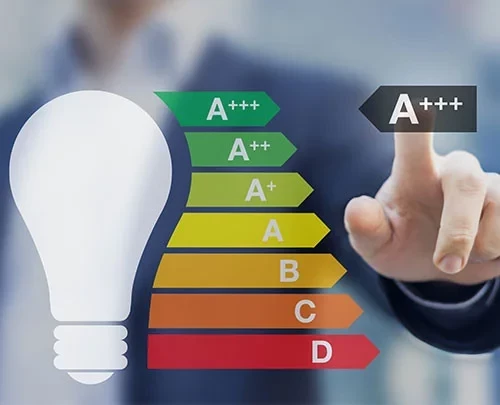Display Energy Certificates (DEC)
The purpose of introducing DECs is to raise public awareness of energy use and to inform visitors to public buildings about the energy use of a building.
DECs provide an energy rating of the building from A to G, where A is very efficient and G is the least efficient and are based on the actual amount of metered energy used by the building over the last 12 months within the validity period of the DEC.
An affected organisation must display a DEC in a prominent place clearly visible to the public and have in its possession or control a valid advisory report.
The advisory report contains recommendations for improving the energy performance of the building.
A DEC shows the energy performance of a building based on actual energy consumption as recorded over the last 12 months within the validity period of the DEC (the operational rating).
This rating is shown on a scale from A to G, where A is the lowest CO2emissions (best) and G is the highest CO2 emissions (worst).
The DEC should be displayed in a prominent place that is clearly visible to members of the public. To enable members of the public to view the document easily, it should be no smaller than A3 in size.
A DEC must be accompanied by an advisory report and the owner of the building must have a valid one available. The advisory report highlights recommendations to improve the energy performance of the building (i.e. its fabric and associated services such as heating, ventilation and lighting)

WHICH BUILDINGS REQUIRE A DEC?
A DEC and advisory report are required for buildings with a total useful floor area over 250m 2 that are occupied in whole or part by public authorities and frequently visited by the public.
For Example:
Only buildings, with a total useful floor area greater than 250m2 , occupied by a public authority and frequently visited by the public are affected by this legislation.
Private organisations, including those that may share a building with a relevant institution, do not need to display a DEC, but may elect to do so on a voluntary basis.

HOW IS A DEC COMPLETED?
An assessor will need to attend the site to conduct a visual inspection and gather the required data. We will also require 12 months worth of bills from the occupier, this may include gas fuels, oil fuels, solid fuels, district heating and cooling, grid electricity and electricity generated on site or obtained by private distribution systems from other sites.
To produce the first DEC and advisory report, the energy assessor must visit the site. In subsequent years the DEC and advisory report can be based on previous knowledge of the building, provided that:
The DEC and advisory report must be lodged on the national register and given a unique certificate reference number. The national register is operated by Landmark
Where the building has a total useful floor area of more than 1,000m², the DEC is valid for 12 months.
The accompanying advisory report is valid for seven years.
Where the building has a total useful floor area of between 250m² and 1000m², the DEC and advisory report are valid for 10 years.
